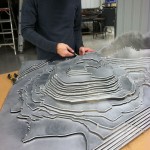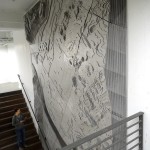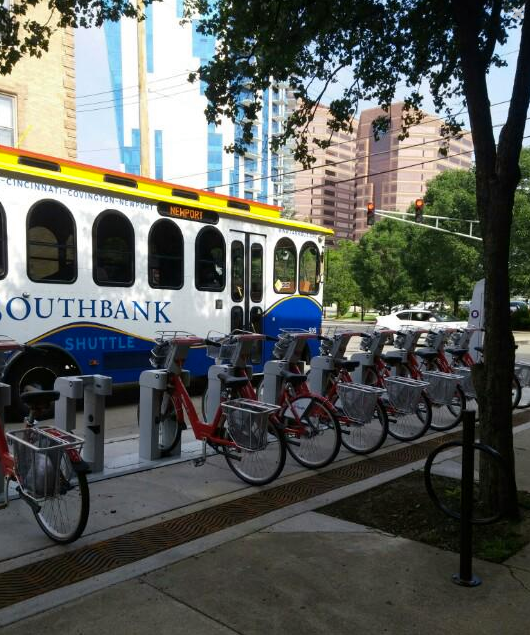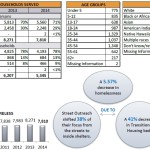Everyone has heard about the craft beer movement and the desires for locally sourced food, but Cincinnati is also experiencing a similar renaissance in the art community.
The Cincinnati Center City Development Corporation (3CDC) has become well-known for the work they are doing to redevelop the city’s historic Over-the-Rhine neighborhood. Their work has created hundreds of new residences and dozens of new shops. Perhaps lesser known is the fact that many of these residences and shops are being designed and outfitted with custom, local art.
Area businesses have also begun embracing local artists. At Taste of Belgium, owner Jean-Francois Flechet says that they worked with local carpenters and artists to design all the tables, furniture and even the bar itself at their hub restaurant at Twelfth and Vine Streets. They also commissioned a large art installation behind the bar.
Flechet says that they have continued this pattern at their newer store on Short Vine in Corryville, and even more so at their soon-to-open restaurant in Norwood.
“We are working on a really cool installation at Rookwood Exchange with Dan and Steve from Brave Berlin,” Flechet said referring to the two men behind the Lumenocity concept. As such, the installation at the new Taste of Belgium in Rookwood will be of the visual display variety.
“We will have animated projected artwork from three projectors,” he explained. “The artwork will evolve throughout the day and updated on a regular basis. It will be really fun and different.”
One of the more dramatic pieces of commissioned art in the center city is ‘Aluminnati’ at 3CDC’s new offices. There, at Twelfth and Walnut Streets, a massive piece of artwork was commissioned for the office’s two-story space connecting the reception area on the fourth floor to offices above.
“When the design team for 3CDC’s new offices created the grand interior staircase between our two levels, we knew that an original piece of art should grace the two-story wall,” explained Anastasia Mileham, Vice President of Marketing and Communications at 3CDC.
Created by Jeff Welch, the piece is an aluminum topographical sculpture of Cincinnati’s center city – a fitting installation for a development corporation that is solely focused on that geographic area. It was a job Welch says he truly enjoyed, and one that he thinks defines a growing interest in custom artwork.
“I believe they [3CDC] must support local artists if we are to rebuild Cincinnati to the cherished quality level established by our ancestors, who built OTR entirely with local artists and craftsmen,” Welch told UrbanCincy. “My experience with 3CDC is that they are very good at supporting local artists, at least in the capacity of their new headquarters, where they had total control over the project.”
Welch was not the only local artist producing work for the new 3CDC office building, and he believes that the growing interest in Cincinnati for locally produced and original artwork is part of a larger national trend, largely being driven by the Millennial generation.
“I believe there is a definitely a local trend toward commissioned art, design and craft, and I’m banking my future on it,” said Welch. “All the new restaurants, shops and businesses seem to be in a competition to feature local craft, or they are at least assuming that something has to be made local. It’s definitely a trend nationwide and Cincinnati is right on-point.”
In fact, he believes in the movement so much that after relocating to Cincinnati in 2009, he started his own design company called Modularem. It’s a movement that is not just tied directly to art, but the larger identity and culture of the city.
“I had gone to UC for undergrad in the early 2000s and had soaked up a lot of the city’s amazing urban history,” Welch explained. “But when we read about the streetcar project, we were sold. That single project represented so much commitment to progress, and enthusiasm for the future, that we wanted to be part of it.”
While his story is unique, he is certainly not alone. According to Mileham, the changing culture of the city is at the heart of its revival.
“Local art is at the heart of everything our organization believes in, and what this OTR community is about,” Mileham said. “The Italian Renaissance-style buildings we renovate are hand-crafted art, the restaurateurs who start businesses in our commercial spaces are local artists, we program the civic spaces that we manage with original music and local performing arts groups.”













